
There’s no shortage of SaaS blogs these days.
As the software space becomes more crowded, company blogs are fighting tooth and nail to attract readers.
But the fight is totally worth it. After all, a blog is one of the best marketing channels for SaaS for the sake of positioning and bringing in qualified leads.
The problem? Too many SaaS blogs are treated as an afterthought.
Outdated content. Copycat posts. Heck, some are just plain boring.
That said, there are plenty of SaaS company blogs that manage to put out creative, compelling posts that actually deliver.
5 common threads between the best SaaS blogs
In this guide, we’ll take a look at what separates the best SaaS company blogs from the so-so ones.
And with that, let’s dive in.
1. They post frequently
No-brainer, right? Your business’ blog shouldn’t gather cobwebs.
However, frequent publishing is particularly important for SaaS businesses.
From new competitors and breaking studies to updated regulations and algorithm changes, the landscape of any industry can change in a snap.
Consider how many new tools hit the market each year (and how often software companies rebrand). Think about how often SaaS startups fold, too. A CRM or SEO tool round-up post today might be unrecognizable from the same type of post a few years ago.
Oh, and don’t forget about ever-changing regulations (remember GDPR?) or algorithm shifts (think: Facebook and YouTube’s so-called “Adpocalypse”).
The takeaway here? Blogs in the software space need to be timely. Many of the most foundational posts of a SaaS content strategy (think: tool lists and statistic round-ups) are time-sensitive.
And so it’s no surprise that the biggest and established SaaS blogs such as Sprout Social publish content multiple times per week.
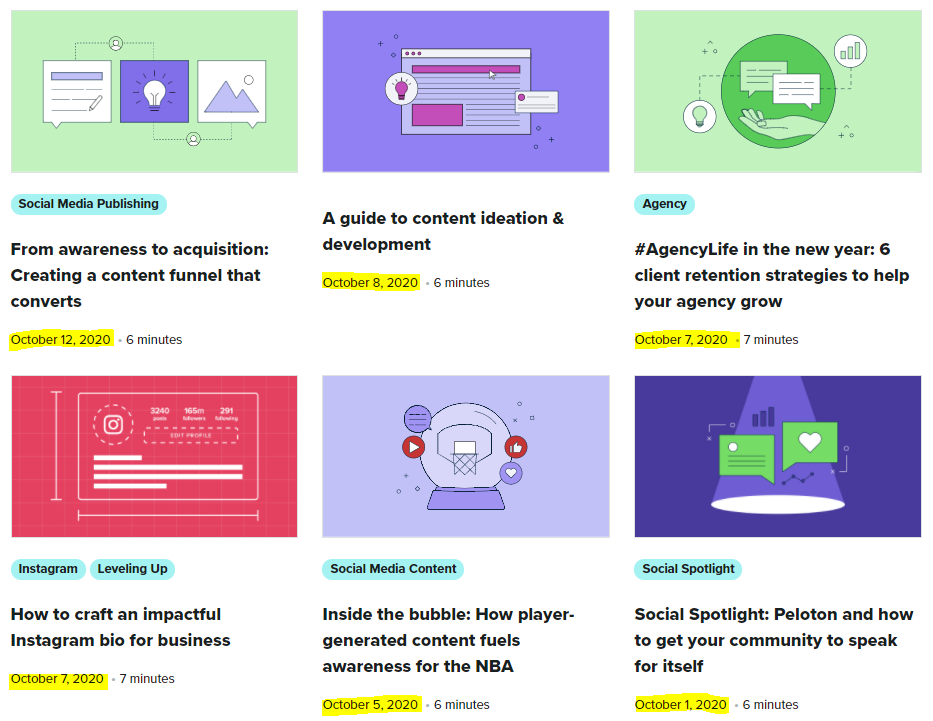
What’s considered “optimal” in terms of publishing frequency is hotly debated. Oft-cited data from HubSpot notes that smaller companies should post at least once per week (if not more) and larger companies should ideally publish content daily.
I’d take that advice with a massive grain of salt, though.
Posting multiple times per week is a tall order for SaaS startups strapped for resources. A lot of larger companies likewise only blog once or twice per week, anyhow. Remember: you don’t want to sacrifice quality for quantity.
This is why updating old blog posts is a smart move, particularly for smaller SaaS blogs.
Rather than pump out post after post, you can continuously update and optimize your core content as needed. This approach ensures that you’re providing legitimate value to your readership while also making sure your posts don’t become outdated. It’s a sort of win-win.
2. They have a distinctive voice
Despite popular belief, SaaS blog posts don’t have to be boring or stiff.
Arguably the best way to set your blog apart from the crowd is to hire a writer that knows how to inject personality into their posts.
For example, the Groove blog does a brilliant job of putting together actionable business guides that are legitimately entertaining (kudos to Nathan, by the way).
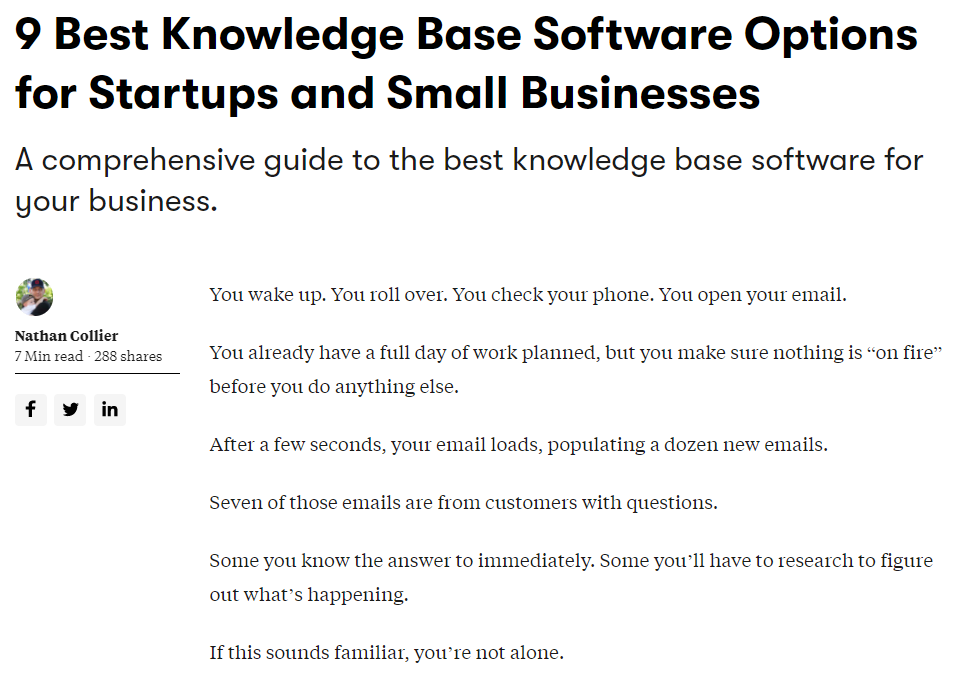
Sure, engaging blog posts can be hard to come by if you’re in a seemingly dull industry. That said, the default tone of a blog shouldn’t be “stuffy” or professional just because you’re writing about software.
You have to get creative. Many SaaS sales blogs (Close.io, for example) absolutely ooze with personality. Companies like SuperOffice manage to take relatively dry topics related to CRM and make them worth reading.
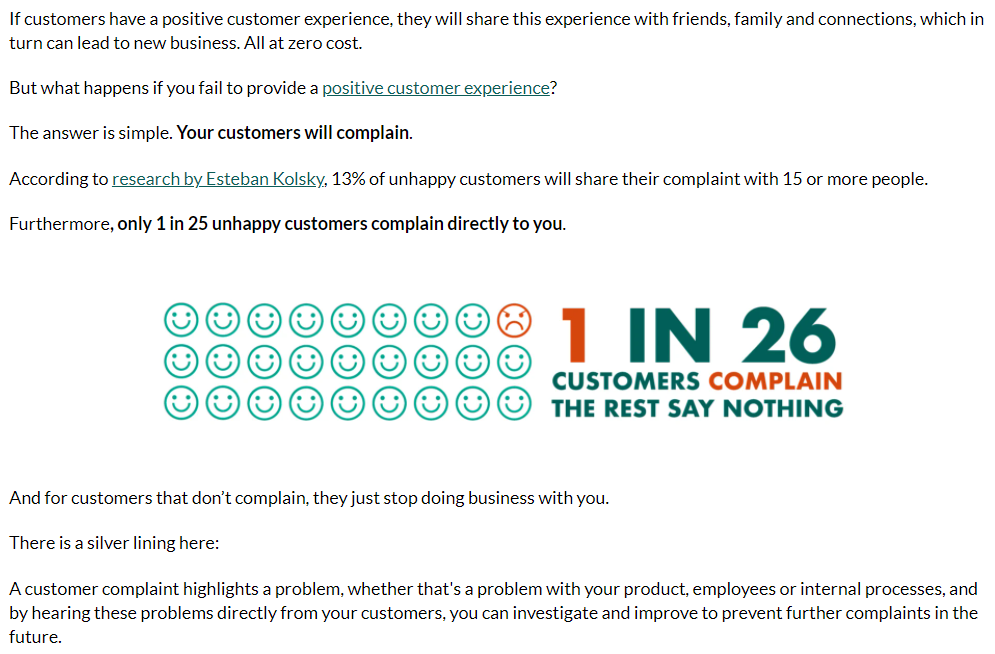
How you talk to your readers boils down to both your brand voice and target audience. That said, presenting yourself as personable is definitely preferable to being totally matter-of-fact.
However, achieving a more memorable voice can be tough for companies that cycle through SaaS bloggers. That’s why it’s preferable to work with writers for the long-term (hint, hint). This empowers your writers to consistently convey the right message as they learn what you’re all about the longer they work with you.
3. They’re willing to tackle topics in depth
As a SaaS writer, I’ve seen an ongoing trend of companies requesting longer, example-heavy posts.
The benefits of long-form content aren’t just for SEO, though. SaaS blogs want to rightfully position their posts as the go-to resource for any given industry.
In-depth posts do double duty of cementing your authority while also building backlinks. They’re likewise prime for sharing across social media.
For example, Venngage regularly publishes in-depth, resource-rich blog posts.

These aren’t just your run-of-the-mill posts, either. Thousands of words, dozens of screenshots and endless nuggets of actionable information, these are the types of posts that SaaS blogs should strive to produce.
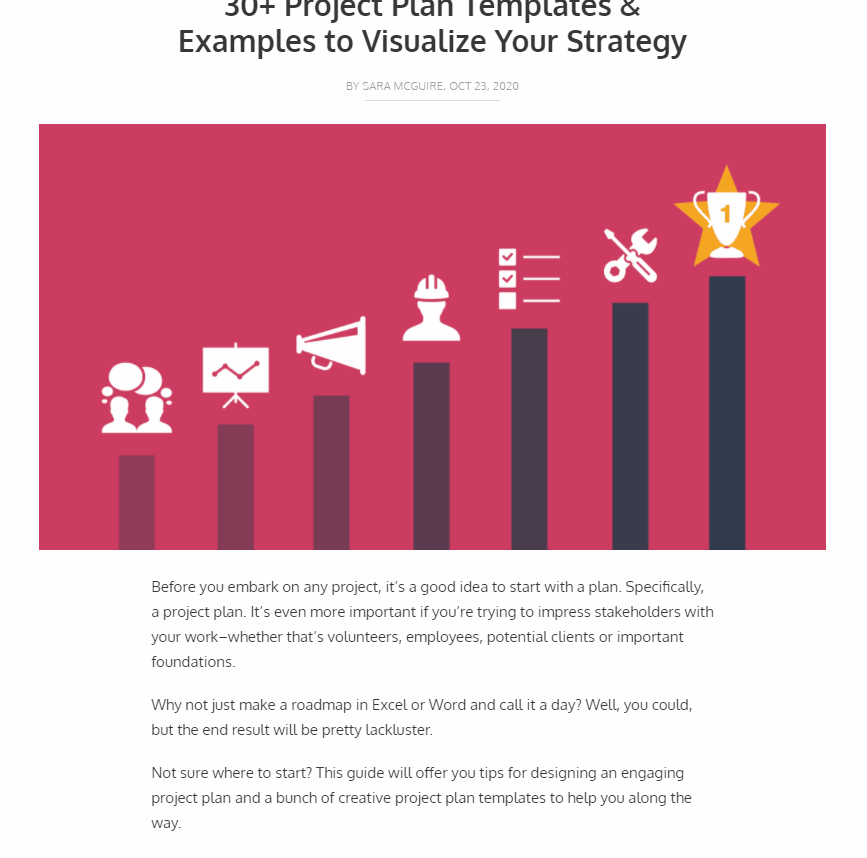
Bear in mind that “depth” means more than meeting an arbitrary word count or quota or examples for a list post. Instead, it means providing something actually useful to readers. Beyond more words or screenshots, think about how conducting an expert interview or sharing a firsthand case study can be just as (if not more) meaningful.
This all may seem obvious, right? But you’d be shocked at how many blogs produce content “just because.”
4. They don’t ignore SEO
Given the investment of time and resources required to run a SaaS company blog, paying attention to SEO just plain makes sense.
Not to mention the fact that blogs are great for attracting top-of-funnel leads via organic search.
I’ve worked with clients that run the gamut when it comes to SEO. Some just want some light keyword mentions here and there. Others come ready with specific SEO briefs. I’ve seen both types of clients succeed at scoring front-page rankings and traffic, too.
The beauty of SaaS blogs is that they can afford to be a bit more aggressive about SEO versus other B2B niches. Blogging for SEO isn’t some sort of big secret, after all. It’s a staple of SaaS marketing.
Even so, keywords and optimization should be somewhat subtle rather than totally in-your-face. The topics covered on HelpScout‘s blog highlight how to find a balance between enticing headlines and targeted keywords.
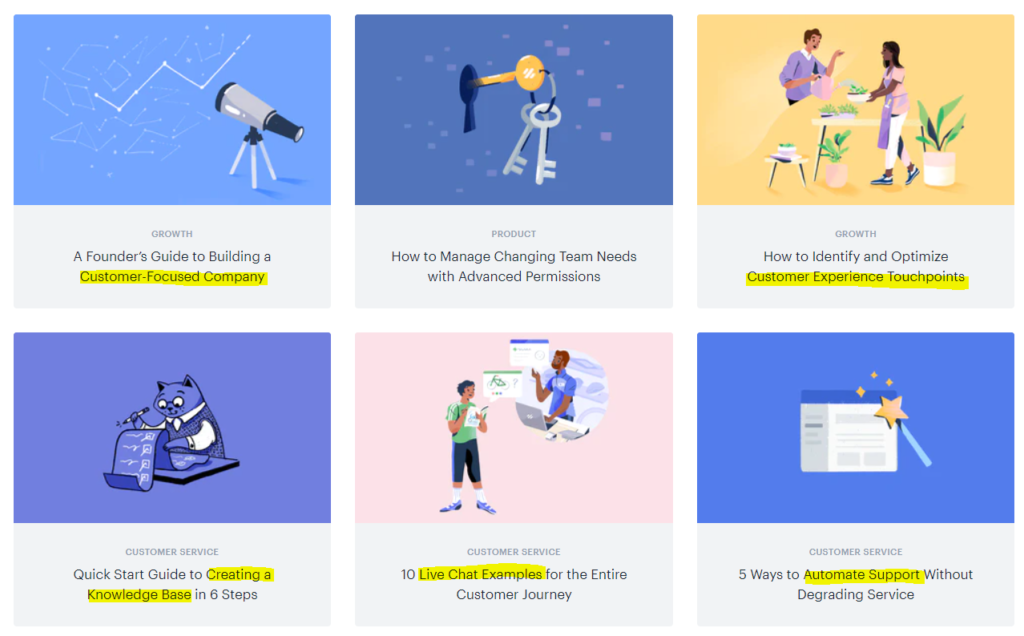
This point also piggybacks on the previous one: in-depth, longer-form articles are a potential goldmine for SEO.
But keep in mind that not all SaaS blogs are hyper-focused on keywords (Basecamp‘s blog, for example). That said, at least some level of optimization is worthwhile for most blogs and a skilled SaaS writer can address SEO without too much hand-holding.
5. Their content covers multiple stage of customer consideration
This is the big one.
As noted in my guide to creating clearer SaaS content, your company blog should cover topics that address readers at the various stages of the buyer’s journey.
That includes people who’ve never heard of you and folks chomping at the bit to test-drive your product. Here’s a quick recap of the various funnel stages that a SaaS blog should cover:
- Top-of-funnel content: general “how-to” and posts that define big-picture industry concepts
- Middle-of-funnel content: tutorials and posts that dig into how a product works
- Bottom-of-funnel content: feature-specific product guides, case studies and app showdowns
Company blogs should hit on all of the above for the sake of their larger SaaS content marketing strategy.
Top-of-funnel content is perfect for driving search traffic and building brand awareness. Meanwhile, middle-to-bottom funnel content can give your readers that final “push” to toward a demo or purchase.
Check out Zapier‘s blog as an example to reach readers regardless of how well they know you. For example, their more general small business tips are accessible to people who aren’t exactly 100% on workflows or automation.
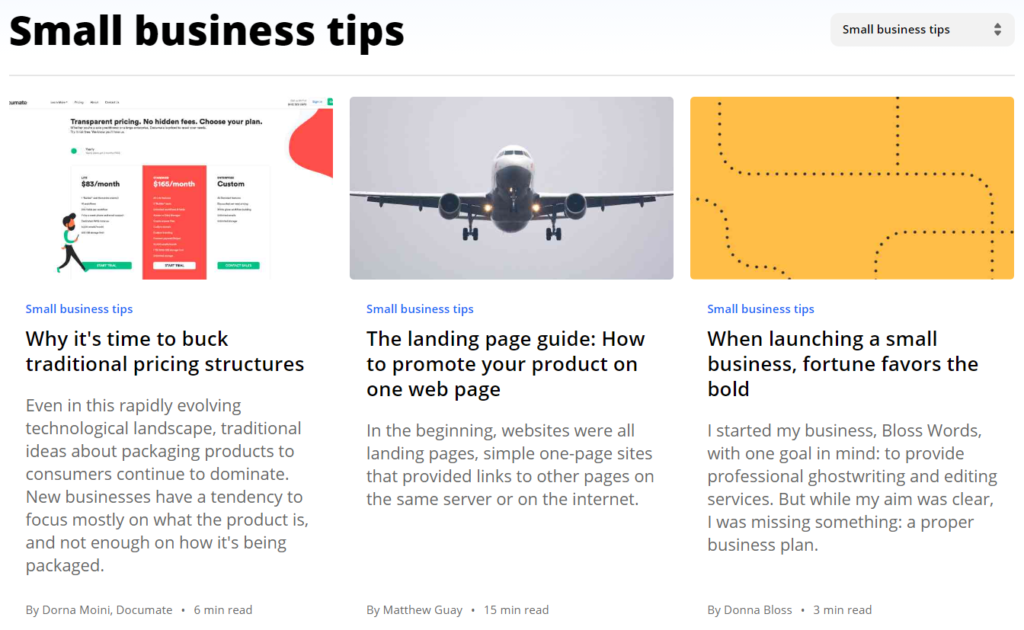
Meanwhile, their middle-of-funnel tips and how-to posts illustrate their product works in practice.
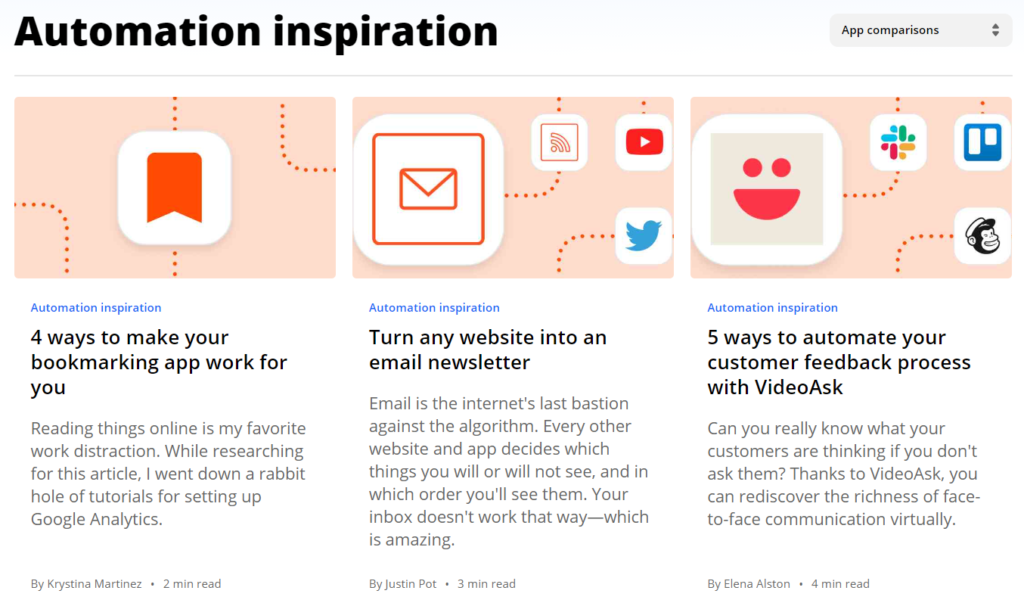
And finally, their customer success stories and case studies help inspire people who need a bit more context on how they might use their product.

See how that works? In short, a SaaS business blogs need to cover a wide variety of topics. Doing so not only gives your blog a sense of flavor, but also ensures that you’re talking to customers regardless of where they are in their journey.
Bonus: 20 of the best SaaS company blogs (and what they do well)
To wrap things up, let’s look at a breakdown of some of the best SaaS blogs (in no particular order). These blogs can provide a much-needed dose of motivation and inspiration for companies both big and small.
1. Trello
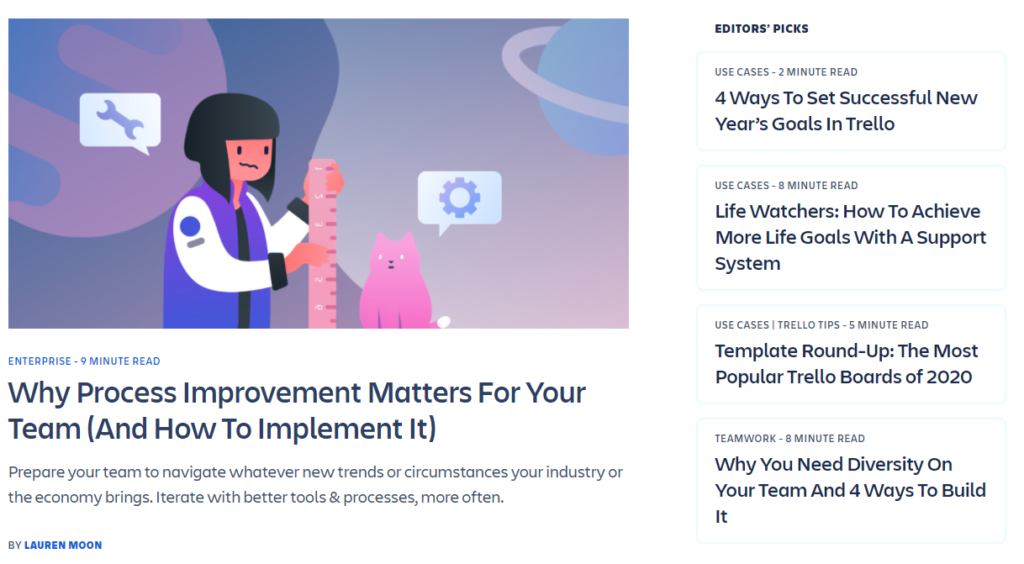
The Trello blog does a brilliant job of balancing meaningful productivity tips with examples of their product in action.
Frequently publishing tutorials and sample boards, they spell out exactly how readers can make the most of their service ASAP. The blog’s playful branding and conversational tone are just icing on the cake.
2. Zendesk
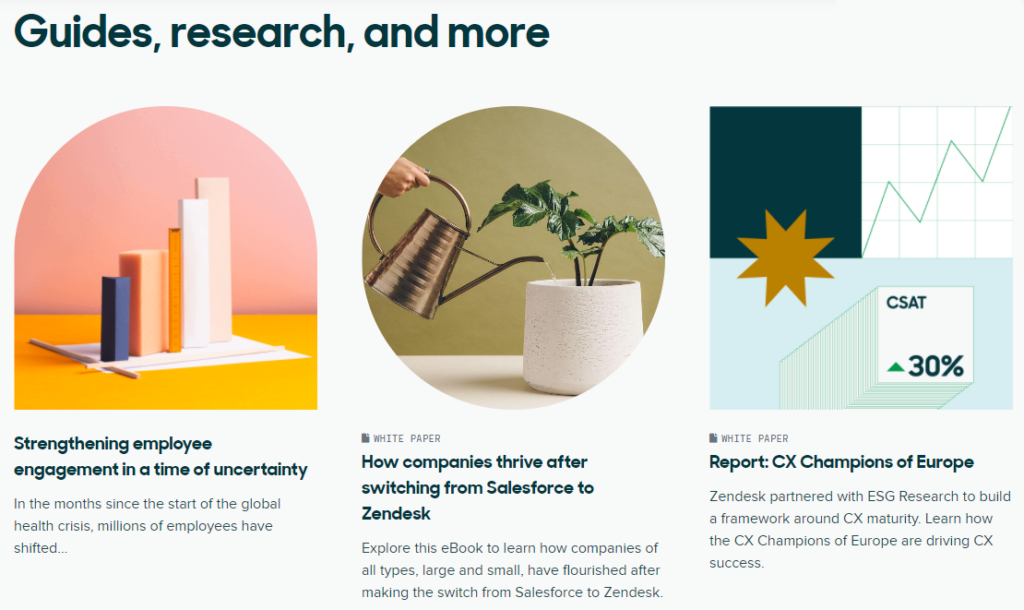
Polished and clearly organized by topic, the ZenDesk blog covers a wealth of content covering each level of the customer journey. Their stockpile of posts is a shining example of how a single SaaS blog can serve as a sort of one-stop-shop for readers.
3. ConvertKit

The ConvertKit blog showcases how a company can position itself as the go-to resource for its target audience (just look at those estimated read times). Their posts are authoritative and in-depth, breaking down the most pressing problems facing folks selling digital products and online courses.
4. Bannersnack

The Bannersnack blog regularly produces example-heavy posts that put their product front-and-center. The fact that the blog is so colorful and aesthetically pleasing is appropriate given their service.
Covering topics from design inspiration to social ads and beyond, Bannersnack’s blog is also an example of how a seemingly straightforward tool can encompass a wide range of content ideas.
5. Visme

Visme’s self-described “visual learning center” is exactly that, providing readers with detailed guides covering every niche of visual marketing.
This is another example of a SaaS blog with distinct, colorful branding that goes hand in hand with what’s being sold. The blog’s massive lists stick to the principle of “show, don’t tell.”
6. Ahrefs
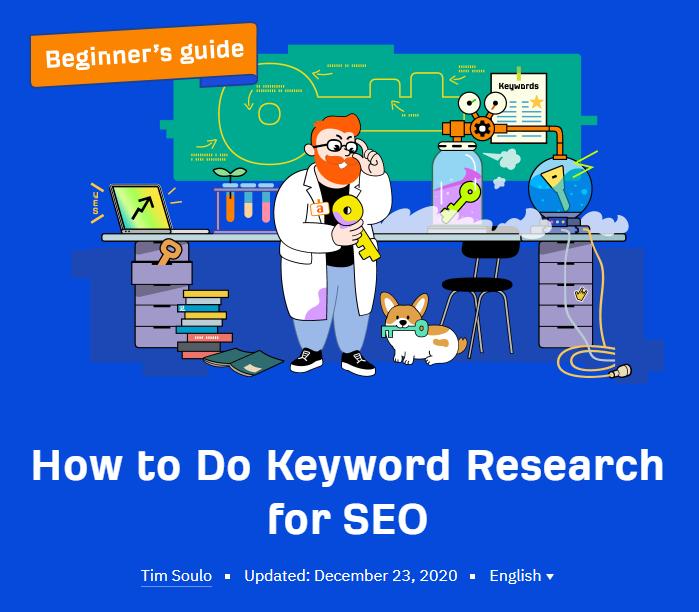
The Ahrefs blog is brimming with SEO advice and firsthand stories from marketers with industry experience. That said, the blog’s content is still accessible and manages to empower readers rather than overwhelm them.
And surprise, surprise: Ahrefs’ content is super SEO-friendly.
7. Sendinblue
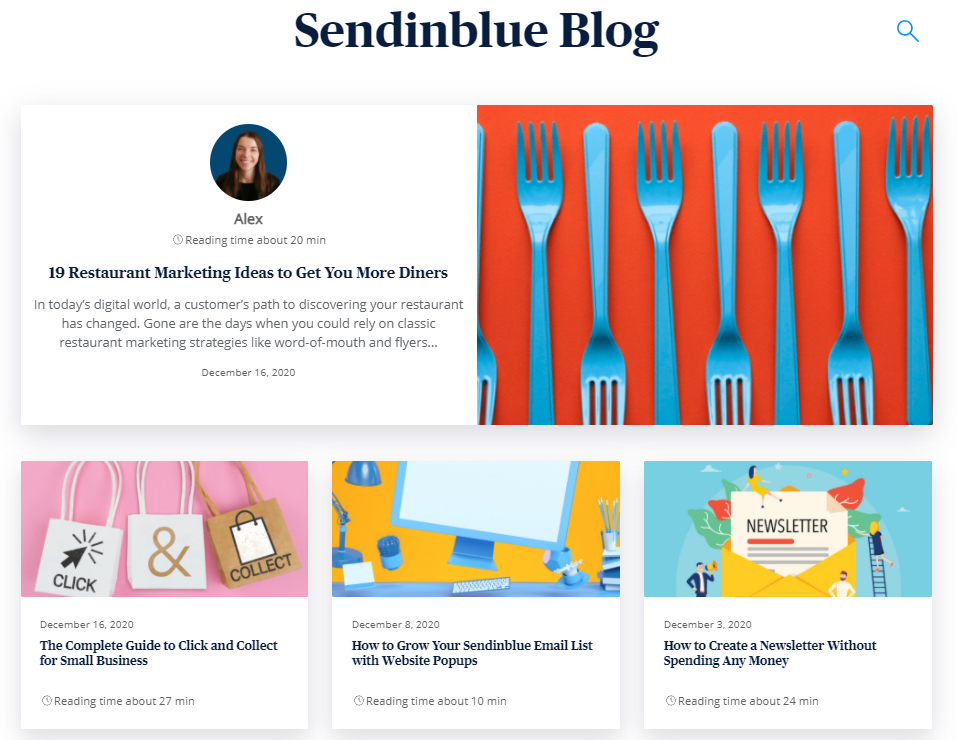
With so many email marketing blogs out there, standing out from the pack is easier said than done.
That said, Sendinblue manages to do so with their industry-specific guides (think: restaurants, ecommerce), attention-grabbing headlines (“How to Create a Newsletter Without Spending Any Money“) and scroll-friendly posts.
8. ClickUp
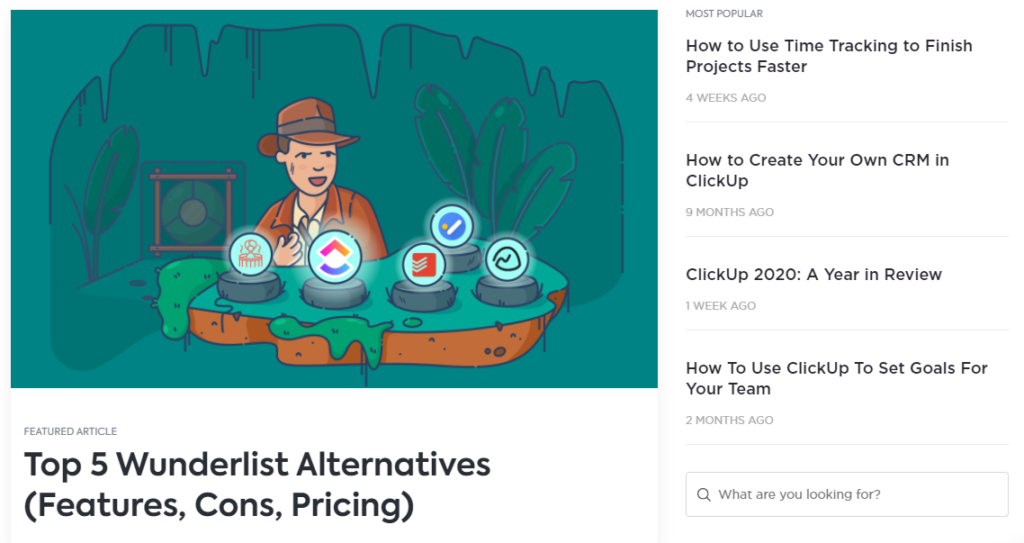
This blog hasn’t been on my radar for long but it’s quickly become one of my favorites. ClickUp’s clever branding, product-driven how-tos and casual content are among the blog’s notable trademarks.
9. Leadfeeder
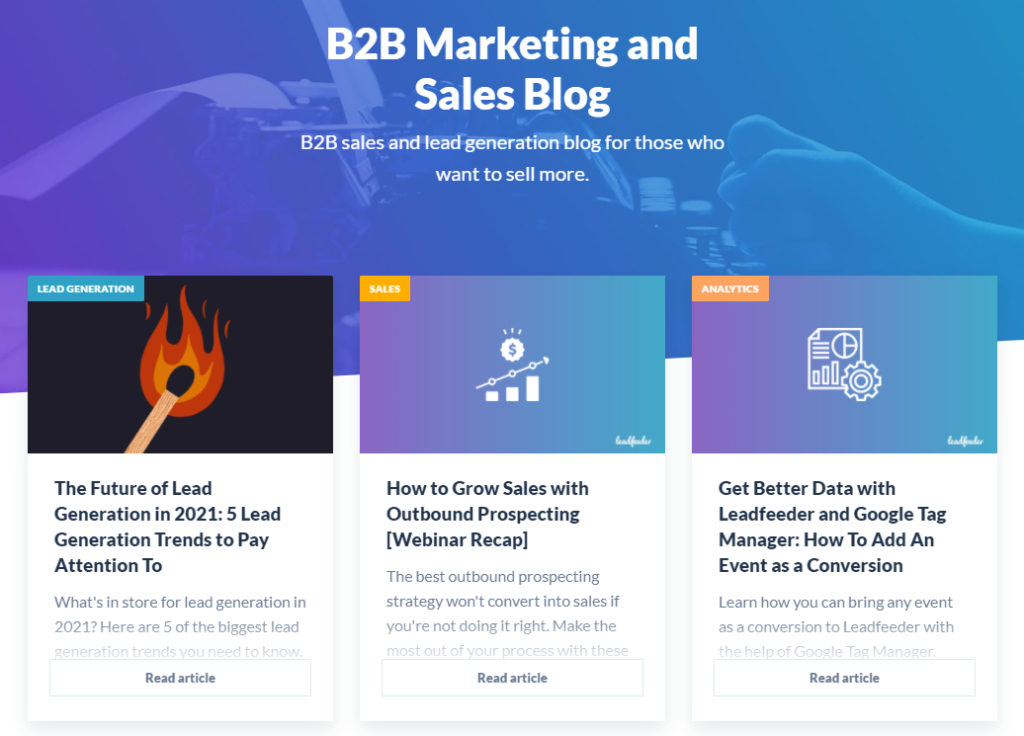
Simply put, Leadfeeder’s blog screams “authority” as soon as you land on it. Their long-form lists and industry-specific guides on lead generation are thorough yet reader-friendly, clearly put together by folks with firsthand experience.
10. CoSchedule

CoSchedule’s content is written by some of the best SaaS bloggers out there, bar-none. Not only do they put out some of the most comprehensive marketing guides online, but they do so consistently.
11. Close.io

As noted earlier, Close.io is a B2B and sales blog with a serious sense of personality. Many of their posts are reminiscent of old-school, direct-response copy (which is totally on-brand for content for sales teams).
12. Sprout Social
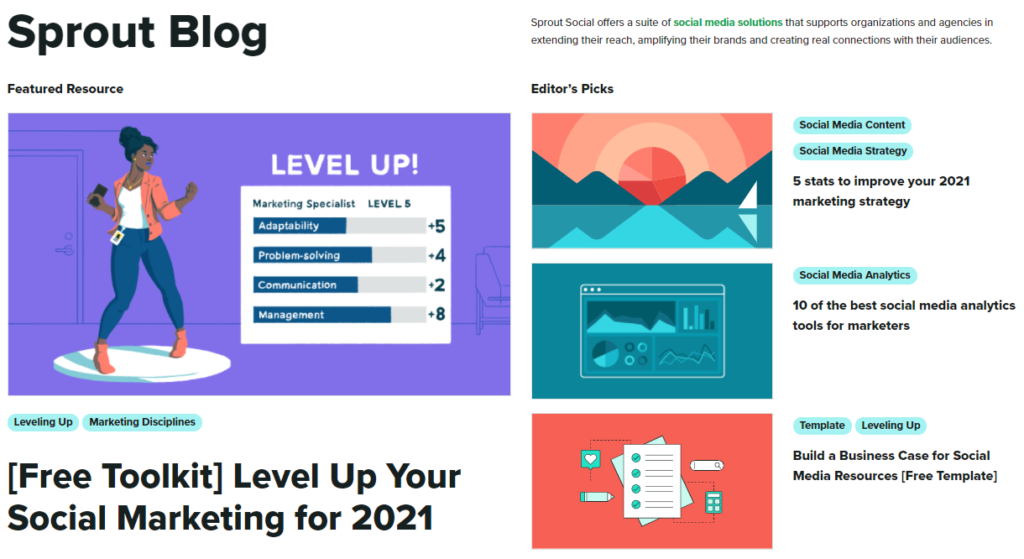
Okay, maybe I’m a bit biased here.
But I can say from firsthand experience that the content team at Sprout works hard to put together the most up-to-date, actionable social media marketing blog out there. I also consider my work for their blog to be among my best.
The blog’s biggest strengths are both its timeliness and depth. Seriously: Sprout has so many bookmark-worthy posts that cover just about every nook and cranny of social media marketing.
13. Groove

In short, Groove puts out conversational posts that tackle real-world customer problems. That’s what all SaaS blogs should do, right?
But Groove’s writers go above and beyond through storytelling and direct-response style copy. These subtle yet creative touches are so refreshing to see in a company blog.
14. Venngage

Venngage was cited earlier as a prime example of an in-depth blog and rightfully so.
They’re likewise an example of “quality over quantity” when it comes to publishing frequency. Although some of their competitors publish content more twice per week, with Venngage you know you’re getting a heavy-hitting guide.
15. SuperOffice
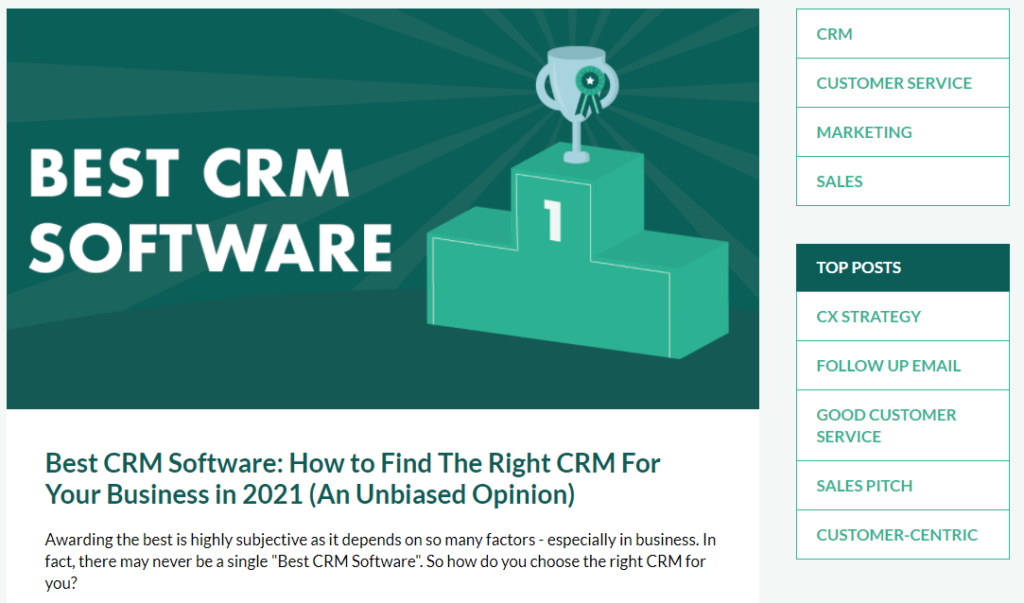
I always find myself circling back to the SuperOffice blog for references, examples and citations for other posts. They’re yet again an example a SaaS blog that goes to great lengths to make sure their posts are up-to-date.
16. HelpScout
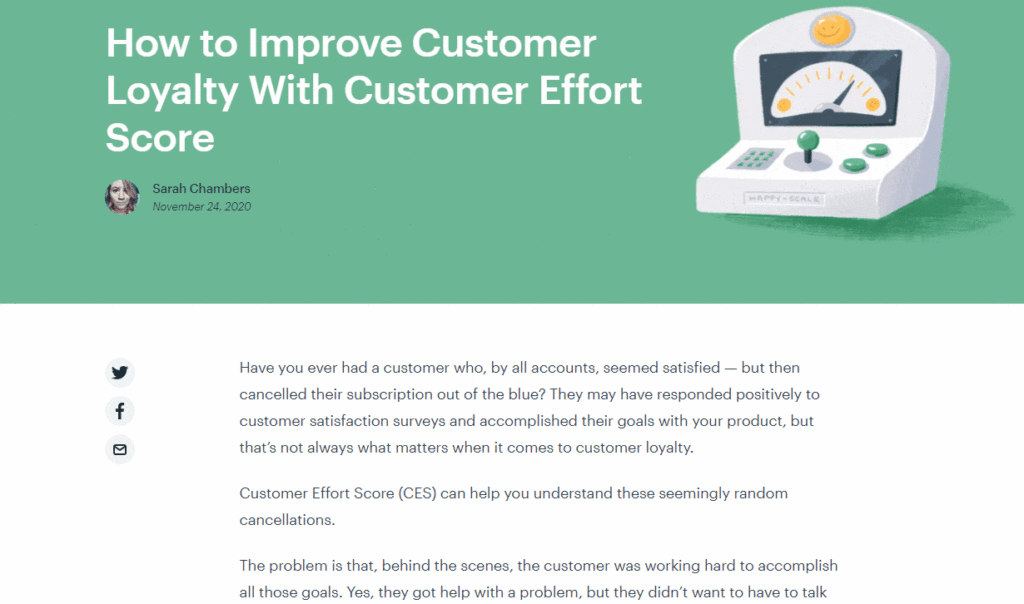
As mentioned earlier, the HelpScout blog produces thoughtful SEO content that doesn’t feel like SEO content. Beyond the data-driven and example-heavy content, the blog’s custom illustrations that couple each post are a nice touch.
17. Zapier
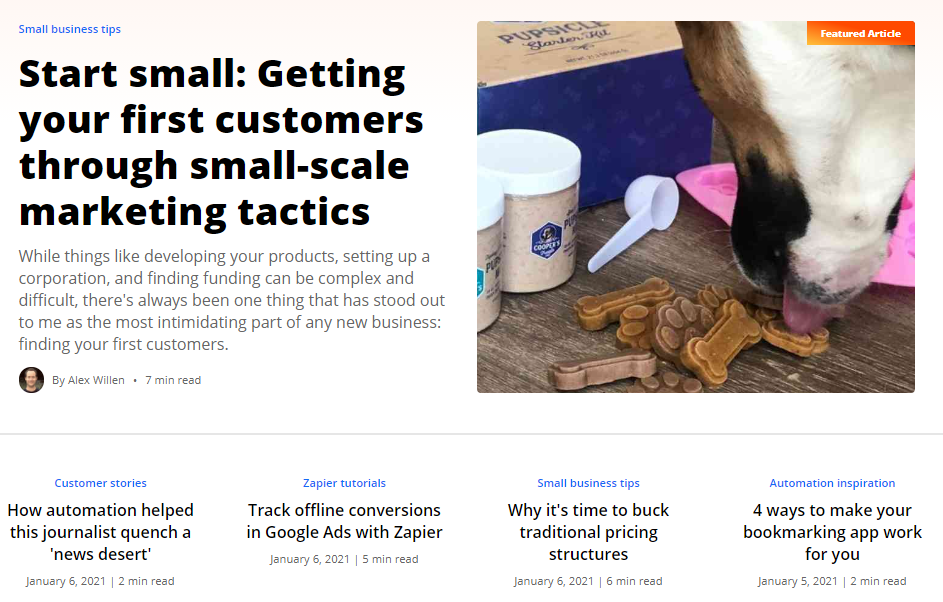
Zapier’s blog makes sure to cover its bases content-wise with a mix of bite-sized stories and guides to more advanced product tutorials. A nice added bonus of their blog is their “New to Zapier? Start here!” call-out to give newbies a hand.
18. Yotpo
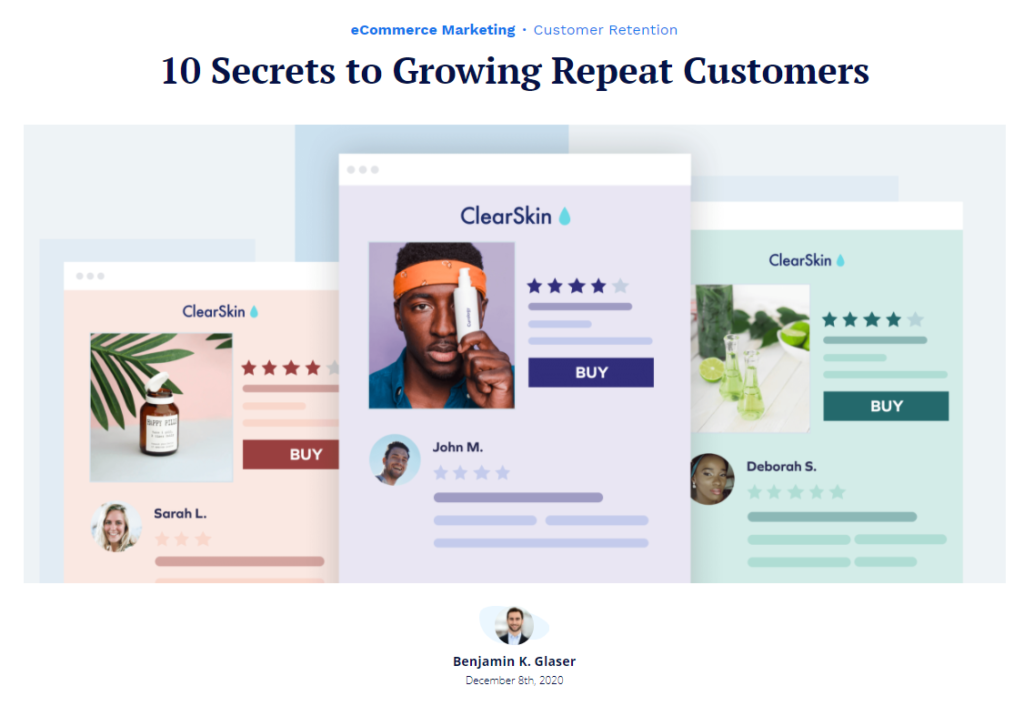
Yotpo is another SaaS blog in a hyper-competitive space (ecommerce marketing). A mix of firsthand Q&As, top-of-funnel posts and product showcases propped up by sleek design help them stand out.
19. Databox

Databox’s roster of writers is a sort of Who’s-Who of professional bloggers that I follow and can vouch for. Extensive round-ups and analytics-driven list posts are among their trademarks. I’m also a big fan of the introductory snippet on each post that gives readers a taste of what’s to come.
20. Wave.video

Wave.video’s blog is a great example of how to put together a blog that takes full advantage of a highly visual product. Inspirational lists, templates and screenshot-heavy resource posts are aplenty here.
What do you consider to be the best SaaS blogs?
Again, there are so many SaaS companies putting out awesome content right now.
Way more than I could possibly cover in a single article, anyway.
Regardless, the best of ’em stick to the five principles outlined above for the sake of standing out, attracting an audience and providing legitimate value to readers.
Any other SaaS companies with great content that deserve some love? Let me know on Twitter, comment below or shoot me an email.
This post was last updated on 1/13/2021.
Great piece. I really do feel like we can learn a lot by learning from other peoples success. I will definitely be implementing some of the tips I learned here.